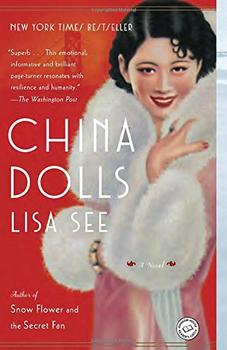Summary | Excerpt | Reading Guide | Reviews | Beyond the Book | Read-Alikes | Genres & Themes | Author Bio

This article relates to China Dolls
San Francisco's Chinatown (the setting of Lisa See's China Dolls) is the oldest in the United States, and the largest confluence of Chinese people and culture outside of Asia. In 2013, the San Francisco Planning Department announced that Chinatown is "the most densely populated urban area west of Manhattan" – some 15,000 residents live in just 20 square blocks. Although there are now four Chinatown areas in San Francisco, the main and original one, established in 1848, is located on Grant Avenue and Stockton Street. The Grant Avenue entrance is guarded by the Dragon Gate, erected in 1970, and the thoroughfare is lined with original 1920s streetlights shaped like golden dragons.
 Between the 1850s and 1900s, Chinatown was the only place in San Francisco where Chinese immigrants were allowed to open businesses or inherit property. The majority of inhabitants were male, often miners, railroad workers, shopkeepers, or restaurateurs. Immigrants were processed at a Western counterpart of Ellis Island, Angel Island in San Francisco Bay, which is now a state park. Restrictive immigration laws such as the Chinese Exclusion Act of 1882 limited the number of Chinese who could settle in the country, and conflict between tongs (secret societies with criminal associations) led to regular outbursts of violence.
Between the 1850s and 1900s, Chinatown was the only place in San Francisco where Chinese immigrants were allowed to open businesses or inherit property. The majority of inhabitants were male, often miners, railroad workers, shopkeepers, or restaurateurs. Immigrants were processed at a Western counterpart of Ellis Island, Angel Island in San Francisco Bay, which is now a state park. Restrictive immigration laws such as the Chinese Exclusion Act of 1882 limited the number of Chinese who could settle in the country, and conflict between tongs (secret societies with criminal associations) led to regular outbursts of violence.
In 1900-1904, 113 residents of Chinatown died of bubonic plague, and the neighborhood was nearly flattened by the earthquake of 1906. The Exclusion Act was finally repealed during World War II, and the 1960s brought another large wave of Chinese immigration, this time from Hong Kong. Many of these more recent settlers have taken up working-class jobs in garment factories or restaurants; they have also skewed the language balance, which is now dominated by the Cantonese dialect.
 Portsmouth Square, known as "The Heart of Chinatown," is one of the community's few open spaces and often hosts t'ai chi practice and Chinese chess matches. It also houses a replica of the Goddess of Democracy statue, a famous emblem of the Tiananmen Square protest. Author Robert Louis Stevenson enjoyed spending time in the square during his San Francisco stay in 1879-80.
Portsmouth Square, known as "The Heart of Chinatown," is one of the community's few open spaces and often hosts t'ai chi practice and Chinese chess matches. It also houses a replica of the Goddess of Democracy statue, a famous emblem of the Tiananmen Square protest. Author Robert Louis Stevenson enjoyed spending time in the square during his San Francisco stay in 1879-80.
Chinatown has two distinct personalities: Grant Avenue is geared toward tourists, while Stockton Street is more authentically Chinese, resembling Hong Kong with its back alleys filled with produce stalls and fish markets. The area houses dozens of restaurants, shops, acupuncturists, galleries, and temples. Other highlights include the Chinese Historical Society of America and the Golden Gate Fortune Cookie Factory, where two women still hand-make 20,000 cookies a day. The Lunar New Year, Miss Chinatown USA pageant, and Autumn Moon Festival in September are major seasonal celebrations. Today Chinatown and the Golden Gate Bridge vie for the title of San Francisco's top tourist location.
Picture of Chinatown Dragon Gate by chensiyuan. From Wikipedia
Picture of replica Goddess of Democracy statue from Wikipedia
Filed under Places, Cultures & Identities
![]() This "beyond the book article" relates to China Dolls. It originally ran in June 2014 and has been updated for the
March 2015 paperback edition.
Go to magazine.
This "beyond the book article" relates to China Dolls. It originally ran in June 2014 and has been updated for the
March 2015 paperback edition.
Go to magazine.
Your guide toexceptional books
BookBrowse seeks out and recommends the best in contemporary fiction and nonfiction—books that not only engage and entertain but also deepen our understanding of ourselves and the world around us.